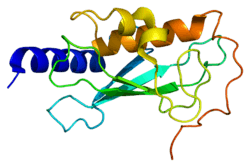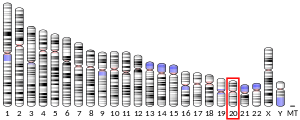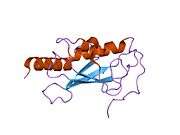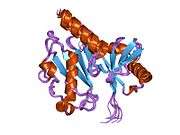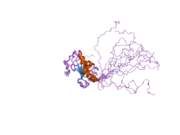UBE2V1
Ubiquitin-conjugating enzyme E2 variant 1 is a protein that in humans is encoded by the UBE2V1 gene.[5][6][7]
Function
Ubiquitin-conjugating E2 enzyme variant proteins constitute a distinct subfamily within the E2 protein family. They have sequence similarity to other ubiquitin-conjugating enzymes but lack the conserved cysteine residue that is critical for the catalytic activity of E2s. The protein encoded by this gene is located in the nucleus and can cause transcriptional activation of the human FOS proto-oncogene. It is thought to be involved in the control of differentiation by altering cell cycle behavior. Multiple alternatively spliced transcripts encoding different isoforms have been described for this gene. A pseudogene has been identified which is also located on chromosome 20. Co-transcription of this gene and the neighboring upstream gene generates a rare transcript (Kua-UEV), which encodes a fusion protein consisting of sequence sharing identity with each individual gene product.[7]
Interactions
UBE2V1 has been shown to interact with UBE2N.[8]
References
- GRCh38: Ensembl release 89: ENSG00000244687 - Ensembl, May 2017
- GRCm38: Ensembl release 89: ENSMUSG00000078923 - Ensembl, May 2017
- "Human PubMed Reference:". National Center for Biotechnology Information, U.S. National Library of Medicine.
- "Mouse PubMed Reference:". National Center for Biotechnology Information, U.S. National Library of Medicine.
- Sancho E, Vilá MR, Sánchez-Pulido L, Lozano JJ, Paciucci R, Nadal M, Fox M, Harvey C, Bercovich B, Loukili N, Ciechanover A, Lin SL, Sanz F, Estivill X, Valencia A, Thomson TM (January 1998). "Role of UEV-1, an inactive variant of the E2 ubiquitin-conjugating enzymes, in in vitro differentiation and cell cycle behavior of HT-29-M6 intestinal mucosecretory cells". Mol Cell Biol. 18 (1): 576–89. doi:10.1128/mcb.18.1.576. PMC 121525. PMID 9418904.
- Rothofsky ML, Lin SL (October 1997). "CROC-1 encodes a protein which mediates transcriptional activation of the human FOS promoter". Gene. 195 (2): 141–9. doi:10.1016/S0378-1119(97)00097-8. PMID 9305758.
- "Entrez Gene: UBE2V1 ubiquitin-conjugating enzyme E2 variant 1".
- Deng L, Wang C, Spencer E, Yang L, Braun A, You J, Slaughter C, Pickart C, Chen ZJ (October 2000). "Activation of the IkappaB kinase complex by TRAF6 requires a dimeric ubiquitin-conjugating enzyme complex and a unique polyubiquitin chain". Cell. 103 (2): 351–61. doi:10.1016/S0092-8674(00)00126-4. PMID 11057907.
Further reading
- Long M (2001). "A new function evolved from gene fusion". Genome Res. 10 (11): 1655–7. doi:10.1101/gr.165700. PMID 11076848.
- Thomson TM, Khalid H, Lozano JJ, Sancho E, Ariño J (1998). "Role of UEV-1A, a homologue of the tumor suppressor protein TSG101, in protection from DNA damage". FEBS Lett. 423 (1): 49–52. doi:10.1016/S0014-5793(98)00060-X. PMID 9580084.
- Xiao W, Lin SL, Broomfield S, Chow BL, Wei YF (1998). "The products of the yeast MMS2 and two human homologs (hMMS2 and CROC-1) define a structurally and functionally conserved Ubc-like protein family". Nucleic Acids Res. 26 (17): 3908–14. doi:10.1093/nar/26.17.3908. PMC 147796. PMID 9705497.
- Ma L, Broomfield S, Lavery C, Lin SL, Xiao W, Bacchetti S (1998). "Up-regulation of CIR1/CROC1 expression upon cell immortalization and in tumor-derived human cell lines". Oncogene. 17 (10): 1321–6. doi:10.1038/sj.onc.1202058. PMID 9771976.
- Hofmann RM, Pickart CM (1999). "Noncanonical MMS2-encoded ubiquitin-conjugating enzyme functions in assembly of novel polyubiquitin chains for DNA repair". Cell. 96 (5): 645–53. doi:10.1016/S0092-8674(00)80575-9. PMID 10089880.
- Deng L, Wang C, Spencer E, Yang L, Braun A, You J, Slaughter C, Pickart C, Chen ZJ (2000). "Activation of the IkappaB kinase complex by TRAF6 requires a dimeric ubiquitin-conjugating enzyme complex and a unique polyubiquitin chain". Cell. 103 (2): 351–61. doi:10.1016/S0092-8674(00)00126-4. PMID 11057907.
- Thomson TM, Lozano JJ, Loukili N, Carrió R, Serras F, Cormand B, Valeri M, Díaz VM, Abril J, Burset M, Merino J, Macaya A, Corominas M, Guigó R (2001). "Fusion of the human gene for the polyubiquitination coeffector UEV1 with Kua, a newly identified gene". Genome Res. 10 (11): 1743–56. doi:10.1101/gr.GR-1405R. PMC 310942. PMID 11076860.
- Ito M, Shichijo S, Tsuda N, Ochi M, Harashima N, Saito N, Itoh K (2001). "Molecular basis of T cell-mediated recognition of pancreatic cancer cells". Cancer Res. 61 (5): 2038–46. PMID 11280764.
- Andersen PL, Zhou H, Pastushok L, Moraes T, McKenna S, Ziola B, Ellison MJ, Dixit VM, Xiao W (2005). "Distinct regulation of Ubc13 functions by the two ubiquitin-conjugating enzyme variants Mms2 and Uev1A". J. Cell Biol. 170 (5): 745–55. doi:10.1083/jcb.200502113. PMC 2171356. PMID 16129784.
- Hau DD, Lewis MJ, Saltibus LF, Pastushok L, Xiao W, Spyracopoulos L (2006). "Structure and interactions of the ubiquitin-conjugating enzyme variant human Uev1a: implications for enzymatic synthesis of polyubiquitin chains". Biochemistry. 45 (32): 9866–77. doi:10.1021/bi060631r. PMID 16893187.
- Syed NA, Andersen PL, Warrington RC, Xiao W (2007). "Uev1A, a ubiquitin conjugating enzyme variant, inhibits stress-induced apoptosis through NF-kappaB activation". Apoptosis. 11 (12): 2147–57. doi:10.1007/s10495-006-0197-3. PMID 17041755.
- Petroski MD, Zhou X, Dong G, Daniel-Issakani S, Payan DG, Huang J (2007). "Substrate modification with lysine 63-linked ubiquitin chains through the UBC13-UEV1A ubiquitin-conjugating enzyme". J. Biol. Chem. 282 (41): 29936–45. doi:10.1074/jbc.M703911200. PMID 17709375.
